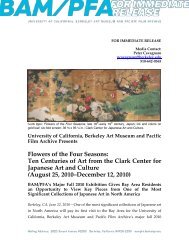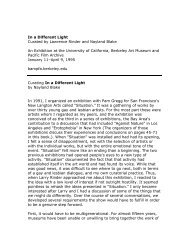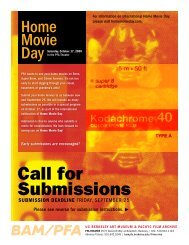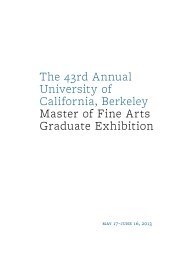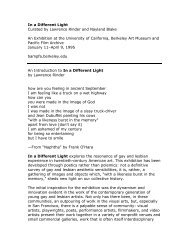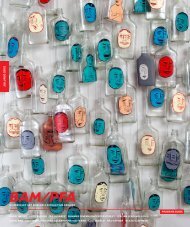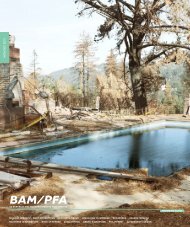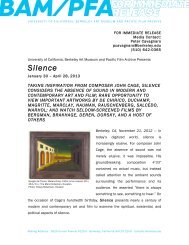January & February 2013 - Berkeley Art Museum and Pacific Film ...
January & February 2013 - Berkeley Art Museum and Pacific Film ...
January & February 2013 - Berkeley Art Museum and Pacific Film ...
- No tags were found...
Create successful ePaper yourself
Turn your PDF publications into a flip-book with our unique Google optimized e-Paper software.
AlfredHitchcockThe Shape of SuspenseIn the 2012 edition of the influential Sight <strong>and</strong> Sound critics’ poll,Alfred Hitchcock’s Vertigo replaced Orson Welles’s Citizen Kaneas the “greatest film of all time.” It was just the latest evidence ofHitchcock’s elevation in the cinephile canon, where he has becomenot a genre-bound Master of Suspense but, in Ian Christie’s words,“the Old Master.” A notion of mastery has long been central tothe reputation of this filmmaker who declared that every filmshould “exist pictorially in the director’s mind from beginning toend” before shooting begins. Yet the Old Master moniker seemsa touch too reverential for a director who often tweaked authoritywith comedy, <strong>and</strong> whose famous technical control gave form touncontrollable emotions.Born not long after cinema itself, Hitchcock (1899–1980) got hisstart in Engl<strong>and</strong> as a titles designer for silent pictures; by the time hedecamped for Hollywood in 1939, he was Britain’s most acclaimeddirector. For viewers more familiar with his American work of the1940s <strong>and</strong> 1950s, this series is a chance to discover the delightsof the British Hitchcock. Screenings continue through April, <strong>and</strong>seeing so many of his films together gives a vivid sense of thedirector’s particular preoccupations. The secret correspondencesbetween the guilty <strong>and</strong> the so-called innocent; love <strong>and</strong> degradation;policemen <strong>and</strong> blondes—returning again <strong>and</strong> again to themes,motifs, <strong>and</strong> images, Hitchcock’s work doubles back on itself, likethat spiral in the opening credits of Vertigo.In the spring, in conjunction with the Silent <strong>Film</strong> Festival, we willpresent a complementary series of Hitchcock silents recentlyrestored by the British <strong>Film</strong> Institute. Watch for details in ourJune/July/August issue.Juliet ClarkSeries curated by Susan Oxtoby. Thanks to the following for their assistancewith this retrospective: Fleur Buckley, British <strong>Film</strong> Institute; Rob Stone, Libraryof Congress; Chris Chouinard, Park Circus; Paul Ginsburg, Universal; MarileeWomack, Warner Bros.; Kristen MacDonald, TIFF Bell Lightbox; Anita Monga,Stacey Wisnia, <strong>and</strong> Lucia Pier, San Francisco Silent <strong>Film</strong> Festival.Get MoreFind the March/April schedule of Hitchcock films on our website,bamfa.berkeley.edu.1/2/3/4/5“Hitchcock is one of the greatest inventors of form in the history of cinema.” —Friday / 1.11.13The 39 StepsAlfred Hitchcock (U.K., 1935)7:00The 39 Steps is one of the most satisfying of theBritish Hitchcocks, a thriller filled with wry humor <strong>and</strong>sophisticated romance—<strong>and</strong> some of the disturbingelements of Hitchcock’s dark silents, as well. RobertDonat’s Richard Hannay may be an innocent abroad(he is Canadian), but he is drawn along in a dangerousintrigue in part by his own desire to know too much.Hannay’s journey is away from innocence toward abroader humanity—toward becoming, like a spy, aman without a country. Locale, from music hall tomoors, is bathed in mystery; a l<strong>and</strong>scape of fog <strong>and</strong>sheep is by turns vampirish <strong>and</strong> serene. Judy BlochWritten by Charles Bennett, Alma Reville, based on a novelby John Buchan. Photographed by Bernard Knowles. WithRobert Donat, Madeleine Carroll, Lucie Mannheim, GodfreyTearle. (87 mins, B&W, 35mm, From Park Circus)8:45SabotageAlfred Hitchcock (U.K., 1936)Sabotage is a prescient thriller that puts London onbomb alert well before the real siege of WWII. It’s a sadlittle film seemingly out of Hitchcock’s subconscious: itdoes away with the law, the cruel father, <strong>and</strong> childhooditself. The settings include a greengrocer’s whosefriendly lettuce salesman is a mole for Scotl<strong>and</strong> Yard;a movie theater where the behind-the-screen “happyfamily” is more brutal than what is on screen; <strong>and</strong> yeolde pet shoppe that is anything but. In marvelouslychoreographed street scenes the constant sideshowbecomes a key element in the story, as a little boyis sent to Piccadilly Circus with a film, a bomb, <strong>and</strong>his youthful curiosity. Judy BlochWritten by Charles Bennett, Ian Hay, Helen Simpson, AlmaReville, E. H. Emmett, based on the novel The Secret Agentby Joseph Conrad. Photographed by Bernard Knowles. WithSylvia Sidney, Oscar Homolka, John Loder, Desmond Tester.(76 mins, B&W, 35mm, From Park Circus)Saturday / 1.12.13The Man Who KnewToo MuchAlfred Hitchcock (U.K., 1934)6:30A British couple on holiday in St. Moritz becomeunwitting pawns in international espionage whenthey are h<strong>and</strong>ed a message from a dying SecretService agent. The desire to know is always “toomuch” in Hitchcock, but those who would be insular,like the vacationing nuclear family in both this <strong>and</strong> the1956 Technicolor remake (screening March 24), arepunished with knowledge. Hitchcock makes brilliantuse of the Albert Hall; Nova Pilbeam, precocious petamongst the anarchists; <strong>and</strong> Peter Lorre, the smilingvillain. Shorter, tauter, more nightmarish in black<strong>and</strong> white (more black than white) than the remake,this version provides its shocks on a need-to-knowbasis. Judy BlochWritten by A. R. Rawlinson, Charles Bennett, D. B. Wyndham-Lewis,Edwin Greenwood, from an original theme byBennett, Wyndham-Lewis. Photographed by Curt Courant. WithLeslie Banks, Edna Best, Peter Lorre, Frank Vosper. (75 mins,B&W, 35mm, From Library of Congress, permission Park Circus)Wednesday / 1.16.137:00RebeccaAlfred Hitchcock (U.S., 1940)Hitchcock’s first American film is a superbly polishedadaptation of Daphne du Maurier’s story of a youngbride (Joan Fontaine) whose marriage is hauntedby the spirit of her husb<strong>and</strong>’s first wife, Rebecca, towhom the brooding bridegroom (Laurence Olivier)<strong>and</strong> his demonic housekeeper (Judith Anderson) areobsessively attached. What begins as somethingof a ghost story develops rather late into a murdermystery <strong>and</strong> finally into what it has been all along,a psychological thriller. At the center is Olivier’ssadomasochistic love-hatred of his wife—both ofthem. Judy BlochWritten by Robert E. Sherwood, Joan Harrison, Michael Hogan,Philip MacDonald, based on a novel by Daphne du Maurier.Photographed by George Barnes. With Laurence Olivier, JoanFontaine, Judith Anderson, George S<strong>and</strong>ers. (130 mins, B&W,35mm, From Swank Motion Pictures)20 january & FEBRuary <strong>2013</strong>



